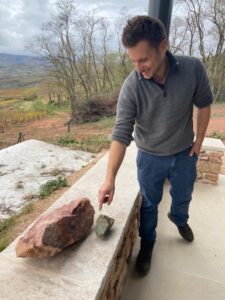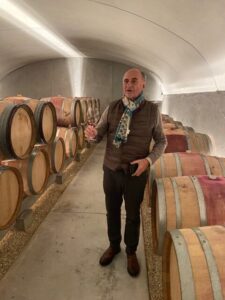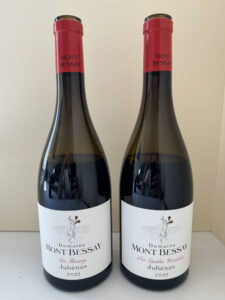
They’re at it again: Domaine du Cellier aux Moines is putting Juliénas on the map with Mount Bessay.
The team at Domaine du Cellier aux Moines has reminded the world that great and distinctive wines can come from Givry (autocorrect, it’s not Gevrey) in the Côte Chalonnaise. Now, they’re doing the same thing in Juliénas in Beaujolais. In 2021, partners Philippe Pascal and winemaker Guillaume Marko established an estate, Domaine Mont Bessay, on the top of that eponymous mountain in Juliénas.
Pascal and Marko complement each other. As a previous CEO of both Veuve Clicquot Champagne and Moët Hennessy, Philippe knows a thing or two about the wine industry. Marko, who had worked at the Domaine Romanée-Conti and other Côte de Nuits-properties, guided the transition to organic farming and biodynamic winemaking at Domaine du Cellier aux Moines. They started those practices immediately at Domaine Mount Bessay.
Juliénas, one of the ten crus of Beaujolais is, even by Pascal’s assessments, “not well-known.” He believes that, though forgotten, it can be the source or distinctive wine, equal to those of the better-known crus, such as Moulin-à-Vent and Fleurie. Pascal points out that historically, Juliénas was revered, especially in Paris. In the early twentieth century, insufficient water transportation from Beaujolais to Paris meant that only premium wines that could withstand the trip over land made it to the capital. Juliénas was just such a wine. And though it seems hard to believe today, at the time it commanded a price like those from Burgundy’s Côte d’Or, according to Pascal. “Juliénas lost its allure after the (Second World) War, but it has the potential to come back. This is our real challenge.”
Pascal recounts how négociant bottling heralded the demise of Juliénas. At the beginning of the twentieth century, growers bottled a vast amount of Juliénas. Now though it’s the négociants, and not growers, who bottle 80 percent of the wine. Compare that to Moulin-à-Vent and Fleurie, where growers bottle three-quarters of the wine. And since most négociants dealing in Beaujolais tend to make a single cuvée when they bottle their Juliénas, individuality of terroir is inevitably lost.
In stark contrast with the négociants, Pascal and Marko intend to restore individuality. Judging by their wines, they have.
From the terrace of their Mount Bessay winery—completed literally days before the 2023 harvest—the diversity of Juliénas’ vineyards spread out on the slopes below is readily apparent, even to the untrained eye. They have a large, triangularly shaped six hectares parcel of the 40 hectares lieu-dit En Bessay, just below the winery, another two hectares piece of En Bessay that extends over an adjacent ridge. From these plots they have vinified three distinct cuvées. A third 0.7 hectares plot, Quatre Cerisiers, named after four cherry trees, lies some distance away. Benjamin Rousset, who joined as the estate manager in 2022, shows just how different the sites are by comparing a piece of blue stone from the Quatre Cerisiers lieu-dit to the red granite from En Bessay (see photo).

They’ve also added parcels in Moulin-à-Vent, the most prestigious of the Beaujolais cru, giving them today about 10 hectares. But their focus remains on Juliénas. Indeed, when tasting a line-up of their wines, they always pour it last.
What makes the project unique—and the wines so captivating—is doing what they did so successfully in Givry: parcelization of the vineyard. They’ve identified subsections within En Bessay, which faces southeast and varies in elevation from 360 to 420 meters, based on soil composition and exposure that allows them to tailor the vines to the site. Even though they are working only with Gamay, the grape expresses itself in a vastly different manner depending on the site, according to Marko. Although the soil in Juliénas, like the rest of Beaujolais, is predominately granite, it is highly varied, with many different types of disintegrated granite, as the team found out from their soil studies. Philippe explains that locals for years have pointed out which parcels within Juliénas are better than others. Marko is emphatic, “We are sure we can make a great wine with Gamay tailoring it to a complex terroir. With pierre bleue (blue stone), Gamay is completely different.” Rousset explains that blue stone is a type of granite of volcanic origin that lacks quartz and imparts a specific character to the wine.
Terroir works in Beaujolais, says Pascal, “if you listen to it.” He continues, “If you listen to the different lieux-dits, plot by plot, you will get great expression.” He adds, “The local farmers have known that for generations.” He faults the négociants for hiding it with massive over-production of generic Juliénas. He wants to emulate in Juliénas what the growers in Pouilly-Fuissé recently accomplished—recognition of Premier Cru vineyards.
He believes they have received, and will receive more, success in Juliénas based on what they’ve learned in Givry at Domaine du Cellier aux Moines. But he adds modestly, “we are here with nothing to impose (by way of Burgundy) and everything to learn.”
For parcelization to allow terroir to speak, the winemaker needs the ability to keep the grapes from parcels separate in the winery. With their new winery the partners have done just that. They have sufficient vats of differing sizes so that they can ferment the grapes and age the wines from the different plots separately. Tasting the 2022 wines from different parcels from barrel, as I did last November, shows the importance of site. Gamay from Quatre Cerisiers displayed firm and structured character, while Gamay from parcels in En Bessay showed elegance and varying amounts of spice complementing its minerality, confirming that the terroir speaks loudly in Juliénas if given the chance.
Despite the enormous investment in the new winery, the partners’ focus remains on the vineyard. To them, the vineyard and its heterogeneity remains the key aspect of their project. In addition to organic farming, they are replanting with a high-density selection massale looking to replace plants that produce “potato-sized” grapes as Pascal described them, with ones that produce smaller berries. Pascal explains that old vines, like the ones they are replacing in Juliénas, are not necessarily the best, if the motivation to plant them was for maximal yield. A massale selection uses cutting from high-quality vines in the vineyard instead of nursery-bought clones and results in more diverse grapes and better wines. High-density planting, though far more expensive, results in a smaller yield per vine. “We do believe that when you have low density you are asking every vine to produce more lower quality grapes, (leading to lower quality wine). Replanting in this manner is a massive undertaking, but crucial to their success, as they showed in Givry.
Luck allowed Pascal and Marko to acquire the 6.0 hectares piece of En Bessay in 2021 from four different growers, two of whom were retiring. They convinced the other two to sell at the same time. The following year they purchased Quatre Cerisiers. Along the way, they purchased the plot in Moulin-à-Vent, and most recently a 0.7 hectares plot in the lieu-dit Côte de Besset in St. Amour, which borders their winery on the north. They also acquired a 1.0 hectres parcel in the limestone-rich neighboring St. Véran appellation for white wine. They plan to bottle wine from those sites in the future. Despite the expansion, Pascal and Marko remain focused on the wines from granite-rich soil of Juliénas.
Marko made the first two vintages, 2021 and 2022, in a rudimentary winery in a garage they rented down the road from their current winery. Luck shined on them again because the weather was cold during vinification, which helped since the garage had no temperature control. The wines from those two first vintages turned out very well, especially considering the conditions under which they were made, due, in part, to a severe selection of grapes.

Marko prefers making red wines over whites. That said, he has made stellar white wines at Domaine du Cellier aux Moines from their Côte d’Or sites. He compares making red wine to being a chef. (His father, in fact, was a chef who worked with Joël Robuchon for 40 years.) He explains that making red wine requires him to make lots of decisions. Like a chef, he tastes what he’s making frequently, often twice a day. In contrast, making whites is, according to him, “like being a pastry chef. You work by the rules. Reds allow you show your soul. With reds, you’re a chef. With whites you’re a technician.”
Unsurprisingly, given Marko’s philosophy, winemaking does not follow a strict formula. The specifics—inclusion of whole bunch, oak aging, duration of fermentation—vary from vintage to vintage. For example, in just these two vintages, Marko has included anywhere from 20 to 100 percent of whole bunches in the fermentation vat. Pascal adds, “The key is to adapt to what Nature is offering.”
Philippe is quick to point out that the animals on the label are hares, not rabbits. He recounts how every time he and Guillaume were scouring Juliénas for vineyards, they would see hares running around. During the mating season they stand on their hind legs and fight each other with their front legs. Philippe remembers that the English have a history of hunting cartoons showing boxing hares, so he felt it would be an apt symbol of the estate. His daughter, Margot, a designer, added the red boxing gloves.
Currently, Domaine Mount Bessay bottles three wines, a Juliénas labeled En Bessay, a Juliénas labeled Quatre Cerisiers, and a Moulin-à-Vent, labeled Le Vieux Bourg. Whether they decide to bottle wine from individual plots in En Bessay separately in the future, which is what they’ve done so successfully in Givry, remains to be seen, according to Pascal and Marko. I suspect they will.
Pascal is not shy about pricing. Domaine Mount Bessay’s En Bessay is likely the most expensive Juliénas ever. But then again, he does have experience selling luxury goods.

(All photos by Michalel Apstein)
The wines
Domaine Mount Bessay 2022 Moulin-à-Vent “Le Vieux Bourg Beaujolais 91
Grapes from their new plantings are not yet included in the wine, so the 2022 is a result of a strict selection from their 0.5 ha plot, composed mostly of granitic sand and located well above the windmill. They destemmed only 20 percent of the bunches prior to fermentation. The wine was aged in used oak for just over twelve months, which is long for Beaujolais. The 2022 is unusually forward for a young Moulin-à-Vent, a characteristic Philippe attributes to the lack of rocks in the sandy granitic soil. It displays a wonderful minerality that complements its black fruit character. Elegance balances and amplifies its firmness, making it delightful to drink now. Drinking window: 2024-2030.
Domaine Mount Bessay 2022 Juliénas En Bessay Beaujolais 93
Like the Moulin-à-Vent, it’s too soon for grapes from their new plantings to find their way into the 2022. Similarly, a strict selection of grapes at harvest and at their rented garage winery helps account for the high quality of the wine. Like the Moulin-à-Vent, 80 percent of the grapes were fermented as whole bunches, but using Burgundian techniques (longer maceration and a mixture of punching down and pumping over), not employing carbonic maceration. They aged the wine for 15 months in French oak barrels, 10 percent of which were new. The stylish and spicy 2022 En Bessay has astounding polish, especially for a Juliénas, whose wines often have a charming rusticity. There’s no rusticity to the 2022 En Bessay. It’s just charm! A seamless combination of red fruit and spice, this mid-weight beauty reveals additional complexity as it sits in the glass, so this is not a wine to rush. Drinking window: 2024- 2035
Domaine Mount Bessay 2022 Juliénas Quatre Cerisiers Beaujolais 95
Mineral-y aromas are evident the minute your nose hits the glass. Firm—but not hard—and stoney, you can almost feel and taste the granite. It’s like no other Juliénas, more reminiscent of Morgon’s Côte de Py or the firmness of the Côte de Brouilly, but with the alluring spice of Juliénas and almost unbelievable suave texture. More structure, to be sure, than en Bessay, but a similar suave elegance cements the family resemblance. A juicy fruitiness emerges in the long finish. The Quatre Cerisiers and the En Bessay put the marvelous differences of the terroir of Juliénas into stark relief. Drinking window: 2025-2040.
Domaine Mount Bessay 2021 Juliénas En Bessay 93
The success of this, their first vintage, is either beginner’s luck, which I doubt, or more likely, careful selection since Marko performed the vinification. The stellar 2021 En Bessay delivers a delightful array of beautifully integrated red fruit and herbal flavors. A charming, slightly rustic, component still shows under a polished patina. A freshness in the finish amplifies its charms. Fine tannins provide support without intruding. Drinking window: 2024-2030.
Domaine Mount Bessay 2021 Moulin-à-Vent Le Vieux Bourg 92
The cooler 2021 vintage—harvest occurred a month later than in 2022—and the lighter soil in the Le Vieux Bourg lieu-dit explains why this lively Moulin-à-Vent is more engaging at this youthful stage than you’d might expect. Still, a charming dark minerality is readily apparent underneath a suave texture. Bright and balanced, this is a Moulin-à-Vent to enjoy now. Drinking window: 2024-2030.
